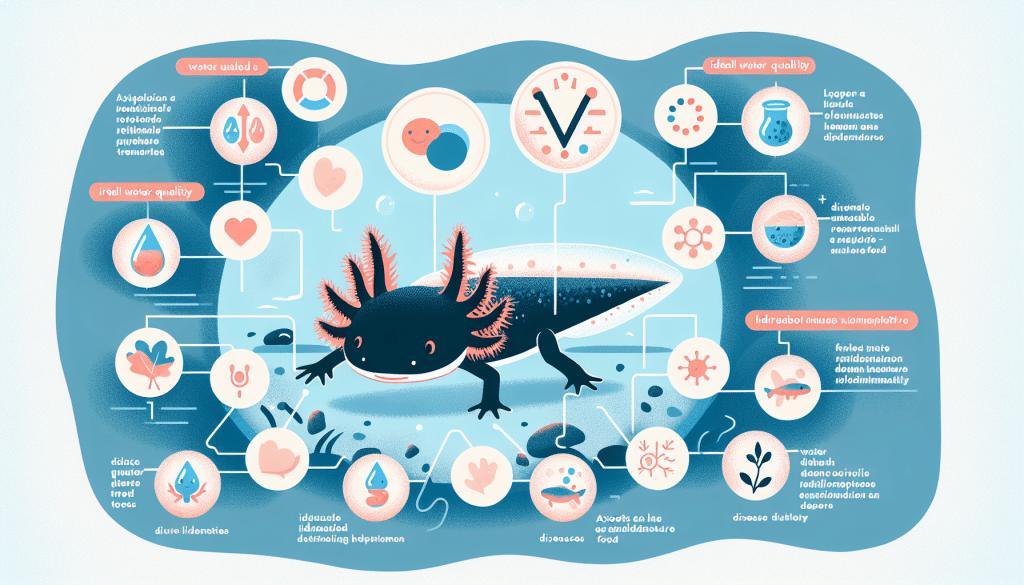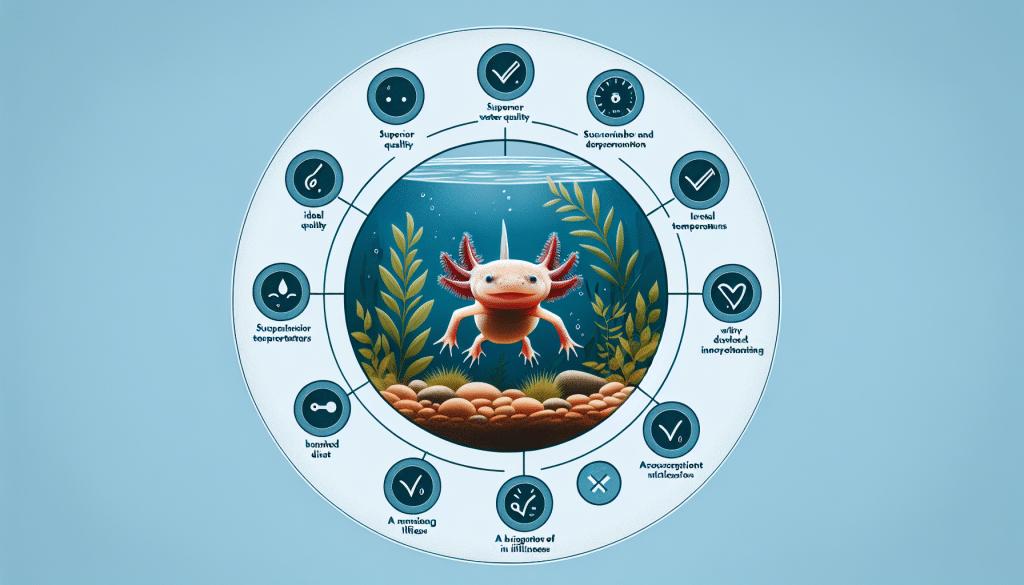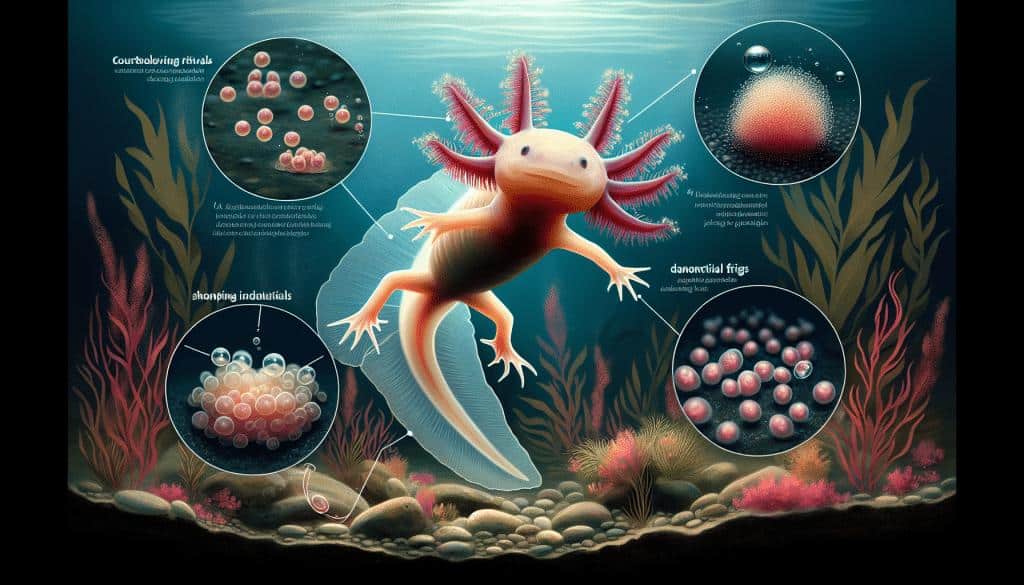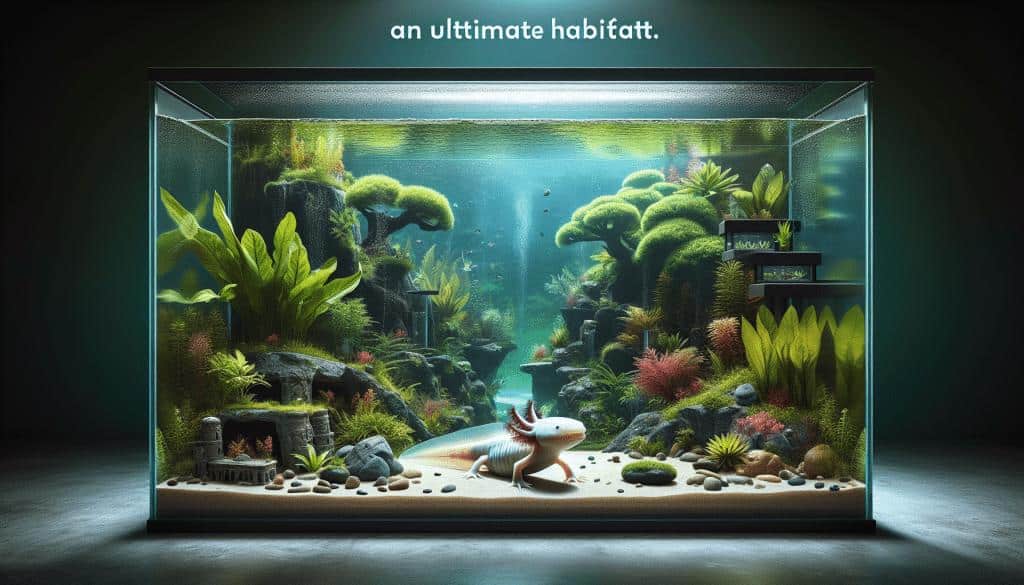You thought owning an axolotl would be a breeze, but now you’re faced with a myriad of health problems. From fungal infections to bacterial diseases, your axolotl is a ticking time bomb of ailments. But fear not, for this article is the key to uncovering the ultimate guide to axolotl health. Brace yourself as we dive headfirst into the world of axolotl care, exposing common issues and equipping you with the necessary knowledge to keep your slimy companion alive and thriving. Get ready to tackle any health hurdle that comes your way, because ignorance is no longer an option.

Understanding Axolotl Biology
Anatomical Features of Axolotls
Axolotls are unique amphibians that possess a set of fascinating anatomical features. Their most distinctive characteristic is their ability to retain their juvenile features throughout their entire life, a phenomenon known as neoteny. This means that unlike other amphibians, axolotls do not undergo metamorphosis and remain aquatic throughout their lifespan. They have external gills that protrude from the sides of their heads, enabling them to extract oxygen from water. They also have long, slender bodies with four limbs, each equipped with tiny fingers and toes. Axolotls come in a variety of colors, ranging from wild type with a dark brown shade to albino and various genetic mutations.
Physiology of Axolotls
Axolotls possess some remarkable physiological traits that contribute to their extraordinary regenerative capabilities. They have the ability to regenerate lost body parts, including limbs, spinal cord, heart, and even portions of their brain. This unique regenerative potential is due to their high concentration of progenitor cells, which possess the capacity to differentiate into various cell types and replace damaged tissues. Axolotls also exhibit remarkable resistance to cancer, as their cells possess an efficient mechanism for preventing the uncontrolled cell growth that characterizes malignancies in most other animals.
Lifespan and Growth Stages
The lifespan of an axolotl can vary depending on various factors, but on average, they can live anywhere between 10 to 15 years in captivity. As they mature, axolotls go through various growth stages. They hatch from eggs as larvae, and during this stage, they possess external gills and rely on microscopic organisms for nutrition. Eventually, they develop lungs and begin to breathe air, transitioning from their aquatic larval stage to a juvenile axolotl. With proper care and nutrition, they continue to grow and reach sexual maturity, ready to reproduce when they are around 18 months old.
Genetic Diversity and Morph Types
Axolotls exhibit a wide range of genetic diversity, resulting in various morph types. While the wild type axolotls have a dark brown coloration and speckled appearance, there are many other color morphs available in the axolotl trade. These include albino, melanoid, leucistic, and various other genetic mutations that result in vibrant and unique color patterns. These morph types are the result of selective breeding and genetic manipulations. Each morph type comes with its own specific traits and characteristics, making the axolotl community an exciting and diverse world for enthusiasts.
Creating a Healthy Axolotl Habitat
Tank Size and Requirements
To ensure the well-being of your axolotl, providing an adequately sized tank is crucial. Axolotls require a minimum tank size of 20 gallons for a single adult, with an additional 10 gallons for each additional axolotl. It’s important to provide ample space for swimming and exploration, as cramped conditions can lead to stress and health problems. The tank should also have a secure lid to prevent escapes, as axolotls are excellent climbers.
Water Parameters and Quality
Maintaining suitable water parameters is essential for the health of your axolotl. The temperature should be kept between 60 to 68 degrees Fahrenheit, as higher temperatures can lead to stress and reduced lifespan. Monitoring and adjusting the pH level to a range between 6.5 to 7.5 is crucial, as well as maintaining low ammonia, nitrite, and nitrate levels by regularly testing the water and performing water changes. Axolotls are sensitive to chlorine, so it’s important to dechlorinate tap water before adding it to the tank.
Substrate and Decorations
Choosing an appropriate substrate for your axolotl habitat is important for their overall health. Avoid using gravel, as axolotls tend to ingest it while feeding, which can lead to blockages and digestive issues. Instead, opt for a fine-grade sand or bare bottom tank setup, which is easier to clean and reduces the risk of impaction. Adding decorations such as plants, rocks, and PVC pipes can provide hiding spots and enrichment for your axolotl, helping to reduce stress and promote natural behaviors.
Filtration and Water Management
Maintaining proper filtration is crucial for water quality and the overall health of your axolotls. A strong filtration system, such as a canister or sponge filter, is recommended to keep the water clean and oxygenated. Regularly monitor and clean the filter to prevent clogging and build-up of waste. Additionally, performing regular partial water changes of around 20% every week can help remove accumulated toxins and ensure optimal water quality for your axolotl.
Temperature and Lighting Conditions
Maintaining a stable temperature within the recommended range is vital for axolotl health. It’s essential to avoid exposing them to extreme temperature fluctuations, as it can lead to stress and compromised immune function. Providing a cool, shaded area in the tank can help regulate the temperature and provide a retreat for your axolotl. As for lighting, axolotls do not require intense lighting and are more comfortable in low-light conditions. Gentle ambient lighting is usually sufficient to simulate their natural environment.

Nutrition for Optimal Health
Understanding Axolotl Diet Needs
To maintain optimal health, it is crucial to understand the dietary needs of axolotls. As carnivorous amphibians, their diet primarily consists of animal-based protein. Their natural diet in the wild includes small invertebrates such as worms, insects, crustaceans, and even small fish. Providing a balanced and varied diet is essential to ensure they receive all the necessary nutrients for growth and overall well-being.
Suitable Food Items for Axolotls
Axolotls can be fed a variety of commercially available live, frozen, or pellet foods specifically formulated for amphibians. Suitable food items include earthworms, blackworms, daphnia, brine shrimp, and high-quality axolotl pellets. It’s important to ensure that the food items are of appropriate size and easily digestible for your axolotl. Avoid feeding them large prey items that could cause choking or impaction.
Feeding Schedules and Portions
Establishing a consistent feeding schedule is essential for maintaining a healthy diet for your axolotl. Young axolotls should be fed daily, while adults can be fed every other day. It’s important to monitor their feeding behavior and adjust the portion sizes accordingly. Overfeeding can lead to obesity and other health issues, while underfeeding can result in malnutrition and stunted growth. Feed your axolotls an amount that they can consume within five minutes, removing any uneaten food to maintain water quality.
Signs of Nutritional Deficiencies
Nutritional deficiencies can have a significant impact on axolotl health. Some signs to watch out for include weight loss, pale coloration, lack of appetite, lethargy, and skeletal deformities. If you suspect a nutritional deficiency, it’s essential to review your axolotl’s diet and consider consulting a veterinarian who specializes in amphibian care for further guidance.
Vitamin and Supplement Usage
In addition to a varied diet, axolotls can benefit from vitamin and mineral supplements. Calcium and vitamin D3 supplements can support healthy bone development and prevent metabolic bone disease. These supplements can be added to their food or incorporated into their water through calcium-rich rocks or cuttlebone. It is important to follow the dosage instructions and consult with a veterinarian experienced in axolotl care before introducing any supplements.
Common Health Issues in Axolotls
Identifying Symptoms of Illness
As an axolotl owner, it’s important to be vigilant and able to identify potential signs of illness. Some common symptoms of illness in axolotls include loss of appetite, unusual swimming behavior, lethargy, abnormal lumps or growths, changes in gill appearance or function, skin discoloration or lesions, and abnormal feces. If you notice any of these symptoms, it’s vital to take prompt action to address the issue and seek veterinary assistance if needed.
Fungal Infections
Axolotls are susceptible to fungal infections, especially in improperly maintained tanks or when exposed to stressful conditions. Fungal infections often manifest as white cotton-like growths on the skin or fins. To treat fungal infections, it’s important to improve water quality, maintain appropriate temperature and humidity levels, and provide proper nutrition. Medications such as antifungal treatments can be used in consultation with a veterinarian.
Bacterial Infections
Bacterial infections can occur in axolotls if they are exposed to unclean water or if their immune system becomes compromised. These infections can present as red or swollen areas on the skin, lethargy, loss of appetite, or even open wounds. In cases of bacterial infection, it is essential to immediately improve water quality, isolate the infected axolotl, and seek prompt veterinary treatment. Antibiotics and topical treatments may be required to combat the bacterial infection.
Parasitic Infections
Parasitic infections, such as anchor worm or parasitic worms, can occur in axolotls. Symptoms may include itching, scratching against surfaces, visible parasites on the skin, or changes in appetite. To address parasitic infections, it is important to maintain excellent water quality, quarantine new arrivals, and administer appropriate medications as prescribed by a veterinarian experienced in axolotl care.
Stress and Impact on Health
Stress can have a significant impact on axolotl health and make them more susceptible to various illnesses. Factors that can contribute to stress include poor water quality, inappropriate tank conditions, sudden changes in temperature, overcrowding, and incompatible tankmates. It is essential to create a stress-free environment by providing suitable living conditions, regular maintenance, and minimizing disturbances to ensure the well-being and longevity of your axolotl.

Preventing Diseases in Axolotls
Quarantine Procedures for New Arrivals
When introducing new axolotls into your tank, it is essential to implement proper quarantine procedures. Quarantine helps prevent the spread of potential diseases or parasites to your existing axolotls. Keep new arrivals in a separate tank for at least one to two months, closely monitoring their health to ensure they are free from any illnesses before introducing them to the main tank.
Routine Tank Maintenance Practices
Routine tank maintenance is crucial for preventing diseases in axolotls. Regularly cleaning and monitoring water parameters, performing partial water changes, and removing excess waste will help maintain optimal water quality and reduce the risk of bacterial or fungal infections. It is important to follow a consistent maintenance schedule to ensure a clean and healthy environment for your axolotls.
Monitoring Water Conditions Regularly
Regularly monitoring water conditions is essential for maintaining optimal health in axolotls. It is recommended to test water parameters regularly using appropriate test kits. Regularly checking temperature, pH levels, ammonia, nitrite, nitrate, and dissolved oxygen levels will help detect any deviations from the ideal range, allowing you to take corrective measures promptly.
Stress Reduction Strategies
Minimizing stress is crucial for maintaining a strong immune system in axolotls. Avoid sudden temperature fluctuations, loud noises, and inappropriate handling, as these can induce stress and compromise their health. Providing appropriate hiding spots, maintaining a stable tank environment, and minimizing disturbances can help reduce stress levels and promote overall well-being.
Proactive Healthcare Screenings
Regular healthcare screenings are recommended to identify any potential health issues in axolotls before they become problematic. This can involve routine veterinary check-ups, thorough health examinations, and diagnostic tests to assess organ function and overall health. Regular screenings can help detect early signs of diseases or infections and allow for prompt intervention and treatment.
Handling Axolotl Injuries and Wounds
Common Causes of Injuries
Axolotls can sustain injuries from various sources, including sharp tank decorations, rough handling, aggression from tankmates, or other traumatic incidents. Common injuries include scrapes, cuts, torn fins, or limb damage. Understanding the causes can help prevent future injuries and maintain a safe environment for your axolotls.
Immediate First-Aid Steps
If your axolotl sustains an injury, it is crucial to provide immediate first aid. Gently transfer the injured axolotl to a separate container with clean water, free from any sharp or abrasive surfaces. Clean the wound gently with aquarium saltwater or a diluted antiseptic solution, monitoring for any signs of infection. If the wound appears severe or your axolotl is in significant distress, consult a veterinarian for further guidance.
Promoting Regeneration and Healing
Axolotls have incredible regenerative abilities that allow them to heal from various injuries. To promote healing, maintain excellent water quality and provide a stress-free environment. Optimizing their diet with adequate protein will also aid in wound healing and tissue regeneration. Observe the wound regularly and monitor for any signs of infection or delayed healing.
Knowing When to Consult a Veterinarian
While some minor injuries can be addressed with proper first aid, certain wounds or injuries may require veterinary attention. If the wound appears deep, shows signs of infection, or does not show signs of improvement within a reasonable timeframe, it is crucial to reach out to a veterinarian who specializes in axolotl care. Prompt veterinary intervention can help prevent complications and ensure proper healing.
Preventing Future Injuries
Preventing future injuries is essential for the long-term well-being of your axolotls. Regularly assess the tank environment, removing any sharp or abrasive decorations that could potentially cause harm. Ensure that tankmates are compatible and monitor their interactions. Handle axolotls with care and avoid excessive force or rough handling. By taking proactive measures, you can significantly reduce the likelihood of injuries and promote a safe habitat for your axolotls.
Detecting and Treating Infections
Common Signs of Infection
Detecting infections in axolotls requires vigilant observation and prompt action. The common signs of infection may include redness, swelling, or inflammation at the site of injury or on the body, changes in behavior, reduced appetite, or fin rot. If you notice any possible signs of infection, it is vital to address the issue promptly to prevent the infection from spreading and causing further harm.
Medications and Treatments
When it comes to treating infections in axolotls, it is essential to consult with a veterinarian experienced in amphibian care. Depending on the severity of the infection, topical or oral medications may be prescribed. Antibiotics, antifungal treatments, or other specialized medications may be used to combat specific types of infections. It is crucial to follow the veterinarian’s instructions carefully and complete the full course of treatment.
Natural Remedies and Preventative Care
In addition to conventional medications, some natural remedies can help support the healing process and prevent infections. The use of salt baths or tea tree oil baths, under the guidance of a veterinarian, may aid in preventing or treating certain infections. However, it is important to use natural remedies cautiously and in conjunction with professional advice to ensure the best outcomes for your axolotl.
Isolation and Quarantine Protocols
If an axolotl is diagnosed with an infection, it is important to isolate them from other tankmates to prevent the spread of the infection. Implementing proper quarantine protocols and maintaining strict hygiene measures can help control the outbreak and protect the health of your other axolotls. Providing a separate and adequately equipped isolation tank will allow for focused treatment and monitoring.
Post-Treatment Care and Observation
After completing the prescribed treatment course, it is crucial to continue monitoring your axolotl closely. Observe for any signs of recurrence or new infections, ensuring that the wound or infection site has fully healed. Continuing to maintain excellent water quality, nutrition, and stress-free conditions will support your axolotl’s immune system and contribute to its overall well-being.
Water Quality Management
Testing Water Parameters
Regularly testing water parameters is a crucial component of effective water quality management. Use reliable test kits to monitor levels of ammonia, nitrite, nitrate, pH, and other essential water parameters. Establishing a baseline for the tank’s water parameters and monitoring any fluctuations will help identify potential issues and allow for proper intervention.
Adjusting pH, Hardness, and Temperature
Maintaining stable pH, hardness, and temperature levels is essential for axolotl health. Axolotls prefer a pH range between 6.5 to 7.5 and a water hardness level between 2 to 8 dGH. Sudden fluctuations or extreme levels can cause stress and affect their overall well-being. If necessary, adjust these parameters gradually using suitable products designed specifically for amphibians, while closely monitoring your axolotl’s response.
Recognizing and Resolving Water Contamination
Water contamination can occur due to various factors, including excess waste, uneaten food, and decaying organic matter. Regular maintenance practices such as partial water changes and the use of appropriate filtration systems will help prevent water contamination. In case of contamination, promptly remove any debris or waste, perform additional water changes, and monitor water parameters closely to restore optimal water conditions.
The Importance of Regular Water Changes
Regular water changes are essential for maintaining optimal water quality in your axolotl tank. Partial water changes of around 20% should be conducted weekly to remove accumulated toxins and ensure proper oxygenation. During water changes, use a siphon to vacuum the substrate and remove debris, making sure not to disturb the axolotls. Be sure to treat new water with a dechlorinator before adding it to the tank.
Filter Maintenance and Benefits
Proper filter maintenance is crucial for effective water quality management. Regularly clean and maintain your filtration system based on the manufacturer’s instructions. Cleaning the filter media and removing accumulated debris will ensure optimal filtration efficiency. A well-maintained filter prevents the build-up of harmful substances, such as ammonia and nitrite, providing a safer and healthier environment for your axolotls.
Molting and Shedding Concerns
Understanding the Molting Process
Molting, or shedding, is a natural process for axolotls and occurs as they grow. During molting, axolotls shed their outer layer of skin, revealing a fresh new layer underneath. It is essential to differentiate between normal shedding and problematic shedding, as it can indicate the overall health and well-being of your axolotl.
Differentiating Between Normal and Problematic Shedding
Normal shedding is a gradual and symmetrical process, where the old skin peels off easily without causing any discomfort or injury to the axolotl. Problematic shedding, on the other hand, may occur if there is an underlying health issue, such as poor nutrition, dehydration, or improper humidity levels. Signs of problematic shedding include remaining patches of old skin, difficulty shedding, or skin that appears to be tight and constricting.
Treating Retained Shed
If you notice signs of problematic shedding, it is important to take immediate action to prevent any complications. Providing a humid hide or moistening the tank environment can help soften the skin and facilitate shedding. Gently and carefully assist your axolotl by manually removing any retained shed if it does not come off naturally. If the problem persists or skin damage occurs, consult with a veterinarian for further guidance.
Environmental Factors Influencing Shedding
Several environmental factors can influence the shedding process in axolotls. Maintaining appropriate humidity levels between 60% to 80% can help ensure the skin remains adequately moisturized, allowing for successful shedding. Providing a moist hide or introducing live plants in the tank can also contribute to a more optimal shedding environment.
Monitoring Shedding as a Health Indicator
Monitoring shedding patterns can serve as an important health indicator for your axolotl. Healthy axolotls shed their skin regularly and evenly, reflecting overall well-being. Irregular shedding or persistent retention of shed skin may signify underlying health issues that require attention. By closely observing shedding patterns, you can catch potential problems early and take appropriate measures to maintain your axolotl’s health.
Record Keeping and Monitoring Health
Importance of Keeping Health Logs
Keeping detailed health logs for your axolotls is essential for tracking their well-being and identifying any potential issues. It allows you to monitor changes in behavior, growth, feeding habits, and any previous health incidents. Documenting this information will help you notice trends, assess any progress or setbacks, and provide valuable information to veterinarians in case of consultations or treatments.
Tracking Water Quality and Diet
Recording water quality parameters is crucial for understanding potential correlations between water conditions and axolotl health. Note the results of regular water tests, including temperature, pH levels, ammonia, nitrite, and nitrate levels. Additionally, maintaining a detailed feeding log that includes the types and quantities of food offered, feeding schedules, and any observed changes in appetite or digestion can help identify dietary issues or deficiencies.
Logging Behavioral Changes
Axolotls can exhibit various behavioral changes that may indicate health concerns. Documenting these changes, such as lethargy, unusual swimming patterns, changes in interaction with tankmates, or aggressive behavior, can provide valuable insights when assessing overall axolotl health. Detailed behavioral logs can help identify patterns, triggers, or unusual behaviors that might require intervention or veterinary attention.
Organizing Veterinary Records
Organizing veterinary records is essential for maintaining a comprehensive health history for your axolotls. Keep track of veterinary visits, prescribed medications or treatments, diagnosed conditions, and any test results. Having organized records readily available can facilitate communication with veterinarians, track progress in healing or treatment plans, and ensure the best possible care for your axolotls.
Using Health Data for Preventative Measures
Regularly reviewing and analyzing the health data you’ve recorded can help identify potential issues before they become significant concerns. By identifying patterns, such as recurring infections or dietary deficiencies, you can take proactive measures to address them promptly and optimize your axolotl’s health and well-being. Using health data for preventative measures enables you to adjust husbandry practices and implement preventive care strategies to promote long-term health in your axolotls.



